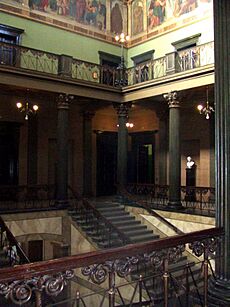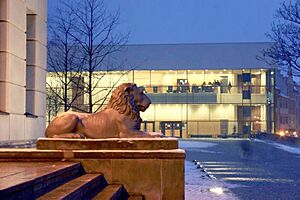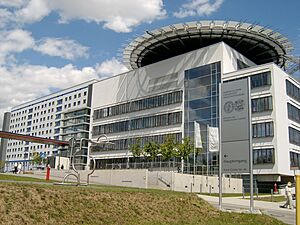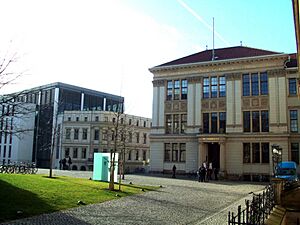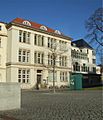Martin Luther University Halle-Wittenberg facts for kids
|
Martin-Luther-Universität Halle-Wittenberg
|
|
 |
|
| Motto | Zukunft mit Tradition |
|---|---|
|
Motto in English
|
Future with Tradition |
| Type | Public |
| Established | 1502 |
| Budget | €182.9 million |
| Rector | Claudia Becker |
|
Academic staff
|
663 |
|
Administrative staff
|
710 |
| Students | 19,319 |
| Location |
,
,
Germany
51°29′11″N 11°58′08″E / 51.48639°N 11.96889°E |
| Campus | Urban |
| Colors | Emerald green |
| Affiliations | Global Compact |
| Mascot | Lions |
Martin Luther University Halle-Wittenberg, often called MLU, is a public research university located in the German cities of Halle and Wittenberg. It is the largest and oldest university in the German state of Saxony-Anhalt. MLU offers classes in both German and English. Students can earn degrees like a Bachelor's, Master's, or even a doctorate.
The university was formed in 1817 when two older universities, the University of Wittenberg (started in 1502) and the University of Halle (started in 1694), joined together. It is named after the famous reformer Martin Luther, who was a professor in Wittenberg. Today, most of the university is in the city of Halle.
Contents
The University's Long History
The story of MLU is the story of two different universities that came together.
University of Wittenberg: A Center for New Ideas
The University of Wittenberg was founded in 1502 by Frederick the Wise. He wanted it to be a place for Renaissance humanism, a movement that focused on human potential and classical studies.
The university quickly became famous because of Martin Luther, a professor of theology. In 1517, he wrote his Ninety-five Theses, which were a list of ideas that questioned some practices of the church at the time. This helped start the Protestant Reformation, a major movement that changed religion in Europe. The university became a key center for these new Protestant ideas.
Some famous fictional characters were said to have studied here, including Prince Hamlet from William Shakespeare's play and Doctor Faustus from a play by Christopher Marlowe.
University of Halle: A Modern University
The University of Halle was founded in 1694 by Frederick III, Elector of Brandenburg. In the 1700s, Halle became a center for the German Enlightenment, a time when people focused on reason and science.
One of its professors, Christian Thomasius, was the first in Germany to teach his classes in German instead of Latin. This was a huge change and made learning more accessible to people. Because of new teaching methods and giving professors more freedom, Halle is sometimes called the first "modern" university.
Two Universities Become One
During the Napoleonic Wars, the University of Wittenberg was closed in 1813. A few years later, in 1817, it was merged with the University of Halle to create the university that exists today. It officially got its current name, Martin Luther University Halle-Wittenberg, on November 10, 1933.
Difficult Times in Germany
During the Nazi period in Germany, the university went through a hard time. More than a dozen professors were forced to leave their jobs because of the government's policies.
What Can You Study at MLU?
Like many European universities, MLU is organized into nine faculties. A faculty is a department that focuses on a specific area of study.
- Theology: The study of religion.
- Law and Economics: The study of rules for society and how money and business work.
- Medicine: For students who want to become doctors.
- Philosophy I, II, and III: These cover many subjects, including history, social studies, languages, music, and education.
- Natural Sciences I, II, and III: These include biology, chemistry, physics, math, farming, and computer science.
Cool Places on Campus
- Botanical Garden: The university has a beautiful botanical garden that was started all the way back in 1698. It's one of the oldest in Germany.
- Observatory: MLU also has a historic observatory, built in 1788, for studying the stars.
Working with Other Research Groups
MLU doesn't work alone. It partners with many other important research centers to make new discoveries. Some of these partners include:
- The German Academy of Sciences Leopoldina (Germany's national science academy)
- The Fraunhofer Institute for studying materials
- Several Max Planck Institutes, which are famous for world-class research in science and anthropology.
- The Helmholtz Centre for Environmental Research
Music at the University
Even though MLU is mainly for academic research, it has a strong music tradition. The university has an orchestra that was founded in 1779 and a well-known choir started in 1950. Together, they are known as the Collegium musicum. The choir often performs at the Handel Festival, which celebrates the famous composer George Frideric Handel, who was born in Halle.
University Rankings
| University rankings | |||||||
|---|---|---|---|---|---|---|---|
| Overall – Global & National | |||||||
|
|||||||
University rankings help compare schools from around the world. In 2024, the QS World University Rankings placed MLU in the top 620 universities worldwide. Another ranking system, ARWU, placed it in the top 700 globally in 2023. These rankings show that MLU is a well-respected university both in Germany and internationally.
Famous People from MLU
Many famous people have studied or taught at the university over its long history. These include:
- Nobel Prize winners: Emil Adolf von Behring, Gustav Ludwig Hertz, Hermann Staudinger, and Karl Ziegler all won this top award for their work in science.
- Georg Cantor: A mathematician famous for his work on set theory and the idea of infinity.
- Anton Wilhelm Amo: The first known Black African to attend a European university.
- Dorothea Erxleben: The first woman to become a medical doctor in Germany.
- Hans Dietrich Genscher: A German politician who served as Foreign Minister and Vice Chancellor for many years.
See also
 In Spanish: Universidad Martín Lutero de Halle-Wittenberg para niños
In Spanish: Universidad Martín Lutero de Halle-Wittenberg para niños
- List of early modern universities in Europe
- List of Martin Luther University of Halle-Wittenberg people
Images for kids





